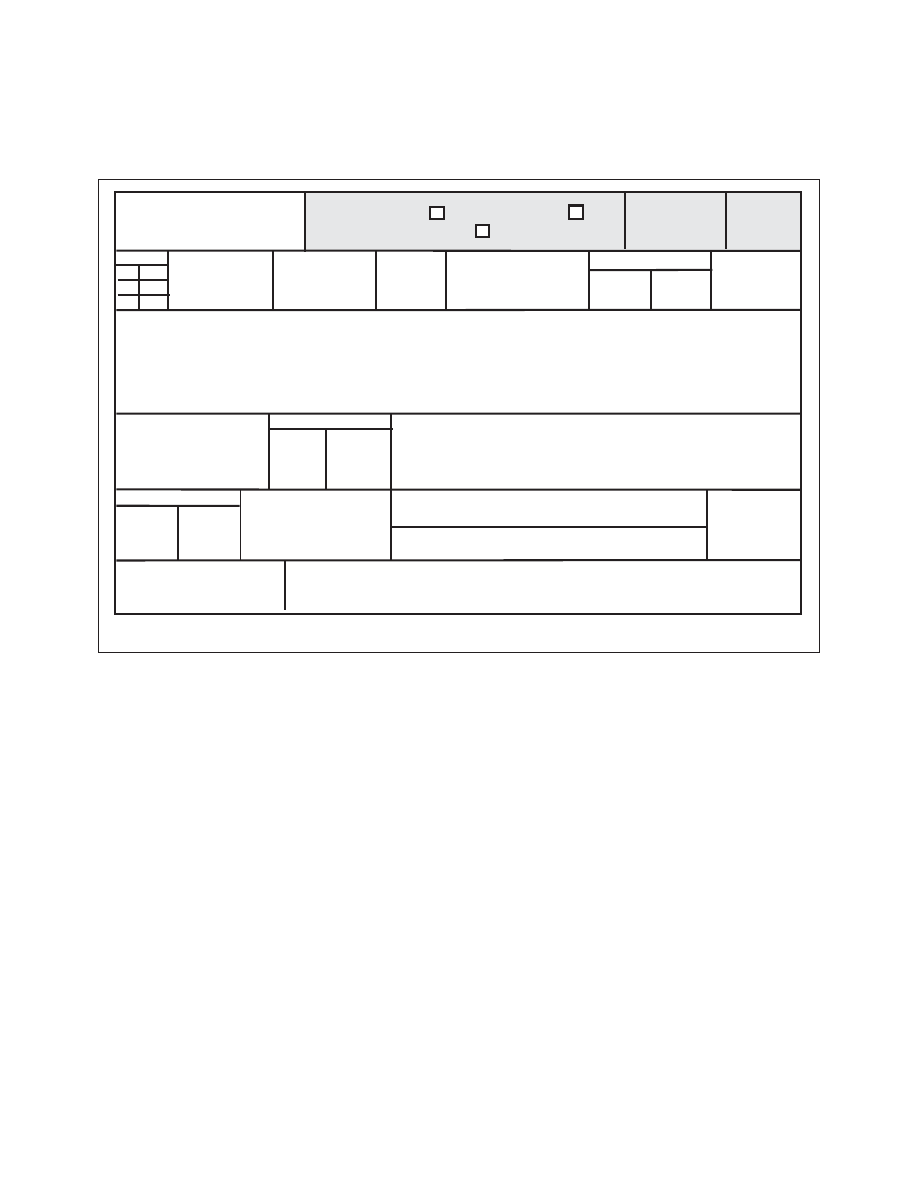
AIM
4/3/14
5−1−16
Preflight
FIG 5
−1−2
FAA Flight Plan
Form 7233
−1 (8−82)
U.S. DEPARTMENT OF TRANSPORTATION
FEDERAL AVIATION ADMINISTRATION
(FAA USE ONLY)
(FAA USE ONLY)
PILOT BRIEFING
PILOT BRIEFING
VNR
VNR
STOPOVER
STOPOVER
TIME STARTED
TIME STARTED
SPECIALIST
INITIALS
SPECIALIST
INITIALS
1. TYPE
1. TYPE
VFR
VFR
IFR
IFR
DVFR
DVFR
3. AIRCRAFT TYPE/
SPECIAL EQUIPMENT
3. AIRCRAFT TYPE/
SPECIAL EQUIPMENT
5. DEPARTURE POINT
5. DEPARTURE POINT
6. DEPARTURE TIME
6. DEPARTURE TIME
PROPOSED (Z)
PROPOSED (Z) ACTUAL (Z)
ACTUAL (Z)
7. CRUISING
ALTITUDE
7. CRUISING
ALTITUDE
8. ROUTE OF FLIGHT
8. ROUTE OF FLIGHT
KTS
KTS
9. DESTINATION (Name of airport
and city)
9. DESTINATION (Name of airport
and city)
10. EST. TIME ENROUTE
10. EST. TIME ENROUTE
HOURS
HOURS
HOURS
HOURS
MINUTES
MINUTES
MINUTES
MINUTES
11. REMARKS
11. REMARKS
12. FUEL ON BOARD
12. FUEL ON BOARD
13. ALTERNATE AIRPORT(S)
13. ALTERNATE AIRPORT(S)
14. PILOT’S NAME, ADDRESS & TELEPHONE NUMBER & AIRCRAFT HOME BASE
14. PILOT’S NAME, ADDRESS & TELEPHONE NUMBER & AIRCRAFT HOME BASE
15. NUMBER
ABOARD
15. NUMBER
ABOARD
17. DESTINATION CONTACT/TELEPHONE (OPTIONAL)
17. DESTINATION CONTACT/TELEPHONE (OPTIONAL)
16. COLOR OF AIRCRAFT
16. COLOR OF AIRCRAFT
FAA Form 7233-1
FAA Form 7233-1
(8-82)
(8-82)
CLOSE VFR FLIGHT PLAN WITH _________________ FSS ON ARRIVAL
CLOSE VFR FLIGHT PLAN WITH _________________ FSS ON ARRIVAL
FLIGHT PLAN
FLIGHT PLAN
CIVIL AIRCRAFT PILOTS, FAR 91 requires you file an IFR flight plan to operate under instrument flight rules in
controlled airspace. Failure to file could result in a civil penalty not to exceed $1,000 for each violation (Section 901 of the
Federal Aviation Act of 1958, as amended). Filing of a VFR flight plan is recommended as a good operating practice. See also
Part 99 for requirements concerning DVFR flight plans.
2. AIRCRAFT
IDENTIFICATION
2. AIRCRAFT
IDENTIFICATION
4. TRUE
AIRSPEED
4. TRUE
AIRSPEED
4. Block 4.
Enter your computed true airspeed
(TAS).
NOTE
−
If the average TAS changes plus or minus 5 percent or
10 knots, whichever is greater, advise ATC.
5. Block 5.
Enter the departure airport identifi-
er code (or the airport name, city and state, if the
identifier is unknown).
NOTE
−
Use of identifier codes will expedite the processing of your
flight plan.
6. Block 6.
Enter the proposed departure time in
Coordinated Universal Time (UTC) (Z). If airborne,
specify the actual or proposed departure time as
appropriate.
7. Block 7.
Enter the requested en route altitude
or flight level.
NOTE
−
Enter only the initial requested altitude in this block. When
more than one IFR altitude or flight level is desired along
the route of flight, it is best to make a subsequent request
direct to the controller.
8. Block 8.
Define the route of flight by using
NAVAID identifier codes (or names if the code is
unknown), airways, jet routes, and waypoints (for
RNAV).
NOTE
−
Use NAVAIDs or waypoints to define direct routes and
radials/bearings to define other unpublished routes.
9. Block 9.
Enter the destination airport
identifier code (or name if the identifier is unknown).
10. Block 10.
Enter your estimated time en
route based on latest forecast winds.